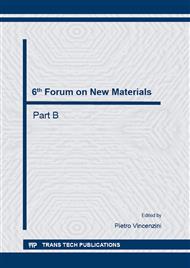[1]
C. Madic, Overview of the Hydrometallurgical and Pyrometallurgical Processes Studied World-wide for the Partitioning of High Active Nuclear Wastes, Proc. JAERI-Conf. 2002-004, Tokai, Japan, Oct. 31-Nov. 2, 2001, (2002) p.27.
Google Scholar
[2]
Z. Kolarik, Current European Research on the Separation of Actinides from High-Level Radioactive Wastes, J. Nucl. Fuel Cycle Envi., 5 (1998) 21.
Google Scholar
[3]
Y. Koma, M. Watanabe, S. Nemoto and Y. Tanaka, Trivalent f-Elements Intra-group Separation by Solvent Extraction with CMPO-complexant System, J. Nucl. Sci. Technol., 35 (1998) 130.
DOI: 10.1080/18811248.1998.9733833
Google Scholar
[4]
Y. Zhu and R. Jiao, Chinese Experience in the Removal of Actinides from Highly Active Waste by Trialkylphosphine-Oxide Extraction, Nucl. Technol., 108 (1994) 361.
DOI: 10.13182/nt94-a35018
Google Scholar
[5]
M. Kubota, I. Yamaguchi, Y. Morita, I. Yamagishi, Separation of Technetium from High-Level Liquid Waste, Radiochemistry, 39 (1997) 299.
Google Scholar
[6]
C.L. Riddle, J.D. Baker, J.D. Law, et al., Fission Product Extraction (FPEX): Development of a Novel Solvent for the Simultaneous Separation of Strontium and Cesium from Acidic Solutions, Solvent Extr. Ion Exch., 23 (2005) 449.
DOI: 10.1081/sei-200058035
Google Scholar
[7]
Y. -Z. Wei, M. Kumagai, Y. Takashima, G. Modolo and R. Odoj, Studies on the Separation of Minor Actinides from High-Level Wastes by Extraction Chromatography Using Novel Silica-Based Extraction Resins, Nucl. Technol., 132 (2000) 413.
DOI: 10.13182/nt00-a3154
Google Scholar
[8]
Y. -Z. Wei, H. Hoshi, M. Kumagai, T. Asakura and Y. Morita, Separation of Am(III) and Cm(III) from Trivalent Lanthanides by 2, 6-bistriazinylpyridine Extraction Chromatography for Radioactive Waste Management, J. Alloys Comp., 374 (2004) 447.
DOI: 10.1016/j.jallcom.2003.11.059
Google Scholar
[9]
H. Hoshi, Y. -Z. Wei, M. Kumagai, T. Asakura and G. Uchiyama, Elemental Groups Separation for High-Level Waste Partitioning Using a Novel Silica-Based CMPO Extraction-Resin, J. Nucl. Sci. Technol., Suppl. 3 (2002) 874.
DOI: 10.1080/00223131.2002.10875608
Google Scholar
[10]
Y. -Z. Wei, H. Hoshi, M. Kumagai, P. Goethals and A. Bruggeman, A Hot Test on Minor Actinides Separation from High-Level-Waste by CMPO/SiO2-P Extraction Resin, Recent Advances in Actinide Science, RSC, London (2006) p.647.
DOI: 10.1039/bk9780854046782-00647
Google Scholar
[11]
A. Zhang, Y. -Z. Wei, H. Hoshi. Y. Koma, M. Kamiya, Chromatographic Separation of Cesium and Strontium from High Level Liquid Waste Using Silica-Based Calixarene-Crown Extraction Resins", Proc. Global, 2005, Tsukuba, Paper No. 056 (2009).
Google Scholar
[12]
Y. -Z. Wei, X. Wang, R. Liu, Y. Wu, S. Usuda, T. Arai, An Advanced Partitioning Process for Key Elements Separation from High Level Liquid Waste, Science China Chemistry, 55 (2012) 1726.
DOI: 10.1007/s11426-012-4697-4
Google Scholar
[13]
S. Usuda, Y. -Z. Wei, R. Liu, Z. Li, Y. Xu, Y. Wu, S. -Y. Kim, Challenges to Develop Single-column MA(III) Separation from HLLW Using R-BTP Type Adsorbents, Science China Chemistry, 55 (2012) 1732.
DOI: 10.1007/s11426-012-4691-x
Google Scholar
[14]
Y. -Z. Wei, T. Arai, H. Hoshi, M. Kumagai, A. Bruggeman and P. Goethals, Development of a New Aqueous Process for Nuclear Fuel Reprocessing: Hot Tests on the Recovery of U and Pu from a Nitric Acid Solution of Spent LWR fuel, Nucl. Technol, 149 (2005).
DOI: 10.13182/nt05-a3591
Google Scholar
[15]
A. Zhang, Y. -Z. Wei, H. Hoshi, M. Kumagai. Y. Koma, T. Koyama, Resistant Behavior of a Novel Silica-Based Octyl(phenyl)-N, N-diisobutyl Carbamoylmethylphosphine Oxide Neutral Extraction Resin against Nitric Acid, Temperature and g-radiation, Radiat. Phys. Chem., 72 (2005).
DOI: 10.1016/j.radphyschem.2004.01.004
Google Scholar
[16]
Z. Kolarik, U. Müllich and F. Gassner, Selective Extraction of Am(III) over Eu(III) by 2, 6-Ditriazolyl- and 2, 6-Ditriazinylpyridines, Solvent Extr. Ion Exch., 17 (1999) 23.
DOI: 10.1080/07360299908934598
Google Scholar
[17]
Z. Kolarik, U. Müllich and F. Gassner, Extraction of Am(III) and Eu(III) Nitrates by 2, 6-Di-(5, 6-dipropyl -1, 2, 4-triazine-3-yl-) pyridines, Solvent Extr. Ion Exch., 17 (1999) 1155.
DOI: 10.1080/07366299908934641
Google Scholar
[18]
Y. -Z. Wei, H. Hoshi, M. Kumagai, T. Asakura and G. Uchiyama, Preparation of Novel Silica-Based R-BTP Extraction-Resins and Their Application to Trivalent Actinides and Lanthanides Separation, J. Nucl. Sci. Technol., Suppl. 3 (2002) 761.
DOI: 10.1080/00223131.2002.10875578
Google Scholar
[19]
H. Hoshi, Y. -Z. Wei, M. Kumagai, T. Asakura and Y. Morita, Separation of Trivalent Actinides from Lanthanides by Using R-BTP Resins and Stability of R-BTP Resin, J. Alloys Comp., 408 (2006) 1274.
DOI: 10.1016/j.jallcom.2005.04.128
Google Scholar


